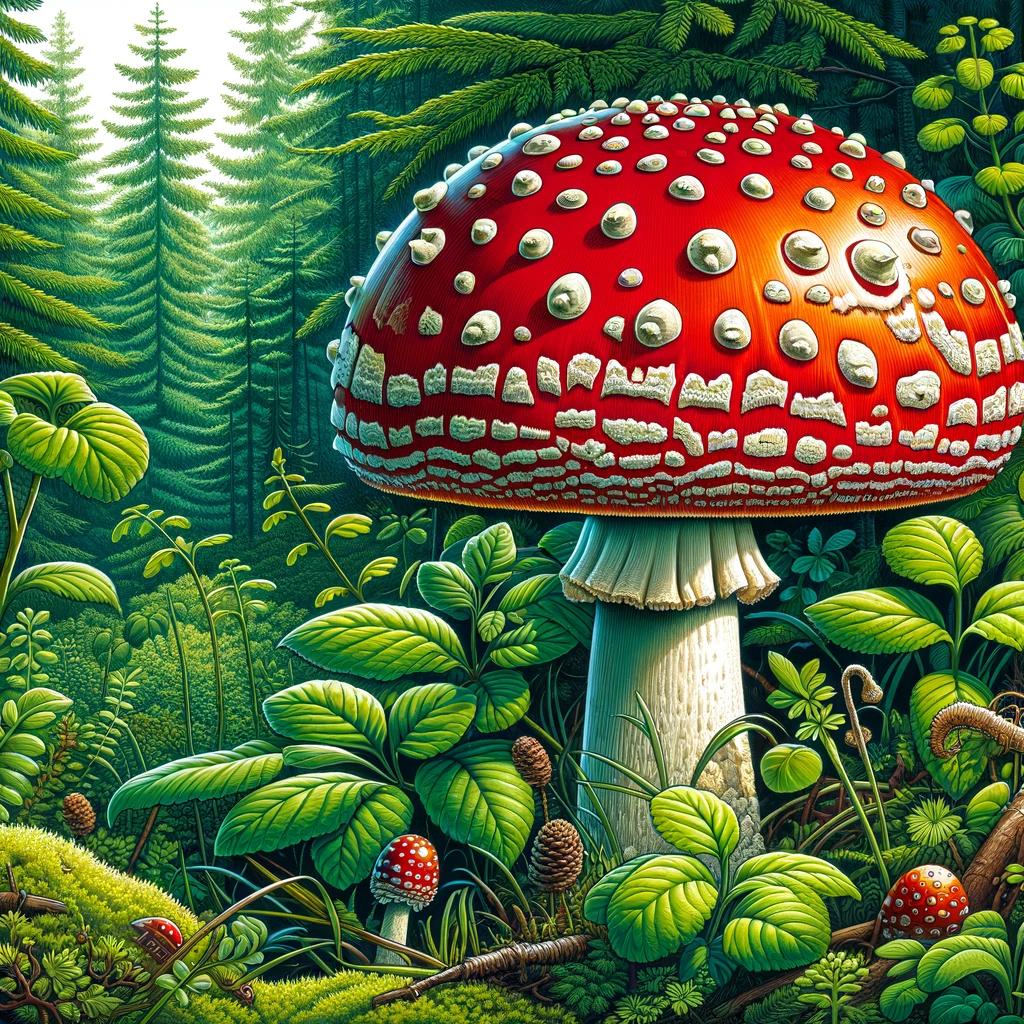Introduction to Amanita Muscaria
Amanita Muscaria, commonly known as the fly agaric mushroom, is one of the most recognizable fungi in the world, famous for its striking red cap with white spots. This iconic mushroom has fascinated people for centuries, not only for its distinctive appearance but also for its rich history in various cultures. This section aims to introduce Amanita Muscaria, delving into its identification and the profound historical significance that has contributed to its almost mythical status in folklore and ancient traditions.
Identification and Characteristics
Amanita Muscaria can be easily identified by its vibrant red to orange cap, adorned with white warts or spots. It typically grows in the temperate and boreal regions of the Northern Hemisphere, flourishing in woodlands and forests, particularly under coniferous trees such as pines and firs. The mushroom emerges from the soil looking like a white egg before the cap breaks through, eventually flattening out as it matures. The gills are free from the stem, and the stem itself is white with a distinctive ring. Understanding these characteristics is crucial for accurate identification, as Amanita Muscaria has several look-alikes, some of which are highly toxic.
Historical Overview
The history of Amanita Muscaria dates back thousands of years, with evidence suggesting its use or representation in various ancient cultures. One of the earliest known connections can be traced to the indigenous peoples of Siberia, where it was used for its psychoactive properties in religious and shamanic rituals. The mushroom was ingested, smoked, or even used as an entheogen, a substance believed to ‘generate the divine within.’ The practice of consuming Amanita Muscaria for spiritual or religious purposes spread across different regions, including parts of Asia and Europe.
Cultural Significance in Shamanic Traditions
In Siberian shamanic traditions, Amanita Muscaria was revered as a sacred substance, facilitating communication with the spiritual world. Shamans consumed the mushroom to enter trance states, during which they believed they could communicate with spirits, heal the sick, and predict the future. The mushroom’s psychoactive effects were considered a gateway to the spiritual realm, offering insights and guidance from the ancestors and nature spirits.
Amanita Muscaria in Mythology and Folklore
Beyond its use in shamanic rituals, Amanita Muscaria has been a recurrent motif in mythology and folklore. In many cultures, it is associated with magic, enchantment, and otherworldly beings. For example, in Slavic folklore, the mushroom is often linked to fairies and magical forests. The iconic appearance of Amanita Muscaria has also inspired countless myths and stories, contributing to its enduring presence in popular culture.
The Mushroom in Ancient Art and Symbolism
The distinctive look of Amanita Muscaria has made it a subject of fascination in ancient art and symbolism. Depictions of the mushroom have been found in various forms of art, including paintings, carvings, and textiles, across different cultures. In some cases, these representations are believed to symbolize immortality, spiritual power, and the cycle of life and death. The mushroom’s appearance in ancient art is not only a testament to its visual appeal but also an indication of its significance in the human psyche.
Early Historical Records and Accounts
The earliest recorded mentions of Amanita Muscaria can be found in the writings of ancient scholars and naturalists. These accounts often describe the mushroom’s intoxicating effects, medicinal uses, and its place in traditional ceremonies. While some historical records offer a factual account of the mushroom’s properties, others are shrouded in myth and superstition, reflecting the complex relationship between humans and this enigmatic fungus.
Amanita Muscaria in World Cultures
The cultural significance of Amanita Muscaria extends beyond its native regions, finding a place in the lore and traditions of various cultures worldwide. In some European folklore, it is associated with magic and is believed to be used by witches. In North America, several indigenous tribes have been known to use Amanita Muscaria for its hallucinogenic properties, though its use was less common than in Siberia. The mushroom’s striking appearance has also made it a familiar symbol in popular culture, often representing whimsy and fantasy.
Psychoactive Properties of Amanita Muscaria
Amanita Muscaria contains several psychoactive compounds, the most notable being ibotenic acid and muscimol. Unlike psilocybin mushrooms, which contain psychoactive tryptamines, Amanita Muscaria’s primary active compound, muscimol, acts on different neurotransmitter receptors in the brain. It primarily interacts with GABA (gamma-Aminobutyric acid) receptors, leading to its distinctive psychoactive effects.
Effects on the Human Mind and Body
The effects of Amanita Muscaria can vary greatly depending on the dosage, preparation, and individual biochemistry. Generally, the effects can include alterations in sensory perception, visual and auditory changes, euphoria, and a sense of dreamlike states. In some cases, users may experience profound spiritual or mystical experiences. However, the effects can also include confusion, nausea, and disorientation, especially with higher doses.
Ceremonial Use and Shamanic Journeys
In shamanic traditions, particularly in Siberia, Amanita Muscaria was used to facilitate spiritual journeys and shamanic practices. The shamans believed that consuming the mushroom allowed them to connect with the spirit world, obtain healing powers, and perform other spiritual tasks. These ceremonial uses of Amanita Muscaria were deeply revered and were integral to the spiritual practices of these cultures.
Modern Perception and Recreational Use
In contemporary times, Amanita Muscaria continues to intrigue and attract individuals interested in its psychoactive effects. While it is not as commonly used recreationally as other hallucinogens, its unique properties and historical significance make it a subject of interest for those exploring natural psychoactive substances. However, its use in modern settings is often approached with caution due to its potency and the variability of its effects.
Understanding the Mushroom’s Impact
The varied responses to Amanita Muscaria highlight the importance of understanding its psychoactive profile. Unlike other more predictable hallucinogens, Amanita Muscaria can produce a wide range of effects, making each experience unique. This unpredictability, along with the mushroom’s potent effects, calls for a cautious and informed approach to its use.
Traditional Uses of Amanita Muscaria
Historically, Amanita Muscaria has been utilized for various purposes, ranging from its use as a fly repellent (hence the common name “fly agaric”) to more spiritual and medicinal applications. In Siberian and Eurasian shamanic traditions, the mushroom was consumed for its psychoactive effects during religious rituals, believed to facilitate communication with the spirit world. In some cultures, it was also used for its analgesic properties to alleviate pain and discomfort.
Amanita Muscaria in Folk Medicine
Aside from its shamanic use, Amanita Muscaria found its place in traditional folk medicine. It was used in small quantities to treat various ailments, such as relieving symptoms of rheumatism and as a remedy for certain neurological disorders. The mushroom was also known for its sedative properties and was sometimes used to induce sleep or reduce anxiety.
Contemporary Uses and Research
In modern times, the use of Amanita Muscaria has shifted significantly. While it is not commonly used for medicinal purposes like other psychoactive mushrooms, it has gained attention in alternative health circles for its unique properties. Ongoing research into its compounds seeks to understand potential therapeutic applications, though this area remains largely unexplored compared to other psychoactive substances.
Debunking Common Myths
There are several myths and misconceptions about Amanita Muscaria, largely due to its psychoactive nature and striking appearance. One common myth is that it is a highly poisonous mushroom. While Amanita Muscaria can be toxic if consumed improperly, it is not as deadly as some of its relatives, like Amanita phalloides (the death cap). Proper preparation can reduce its toxicity, though caution is always advised.
The Reality of Its Psychoactive Effects
Another misconception is regarding the nature of its psychoactive effects. Unlike psilocybin mushrooms, Amanita Muscaria does not produce the same kind of ‘trip’ and its effects can be less predictable. The experiences can vary widely from person to person, and the same user may have different experiences at different times.
Cultural Misinterpretations
Cultural misinterpretations have also played a role in shaping the public perception of Amanita Muscaria. Its depiction in popular media often exaggerates or inaccurately represents its effects and uses, leading to a distorted understanding of the mushroom.
Safety Considerations and Risks
When it comes to Amanita Muscaria, safety is a paramount concern due to its psychoactive compounds. While not lethal like some of its Amanita relatives, improper consumption can lead to unpleasant and potentially harmful effects. Symptoms of Amanita Muscaria poisoning can include nausea, dizziness, confusion, and in severe cases, hallucinations and seizures. It is crucial to understand the correct preparation methods, as these can significantly reduce the mushroom’s toxicity.
Responsible Use and Dosage
Given its potent effects, responsible use of Amanita Muscaria is essential. This includes being mindful of the dosage, as the line between a safe and an overwhelming experience can be thin. Beginners are advised to start with very small amounts and to never consume the mushroom alone or without informing someone of their intention. It’s also important to source the mushroom from reliable and knowledgeable suppliers to ensure proper identification and quality.
Legal Status Around the World
The legal status of Amanita Muscaria varies globally. In some countries, it is legal to possess and use, while in others, there are restrictions or outright bans. For example, in the United States, Amanita Muscaria is not regulated by the federal government, but local laws may differ. In contrast, countries like the Netherlands have imposed restrictions on its sale and use. Users should be well-informed about the legal status in their region to avoid legal issues.
Closing Thoughts on Amanita Muscaria
Amanita Muscaria stands out as one of the most intriguing and iconic mushrooms in nature, known for its striking appearance and complex history. From its traditional use in shamanic rituals to its role in folklore and modern culture, the mushroom has captivated human interest for centuries. While it continues to be a subject of fascination and study, it remains a mushroom that demands respect and caution due to its psychoactive properties and potential risks.
Encouraging Informed Exploration
For those interested in exploring the world of Amanita Muscaria, this series offers a foundational understanding. The journey into the realm of such a unique and potent mushroom should be approached with caution, respect, and a desire for knowledge. Whether it’s through academic study, cultural exploration, or personal interest, Amanita Muscaria invites a journey that intertwines nature, history, and human experience.





